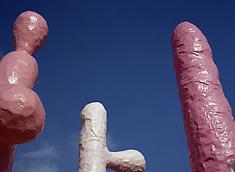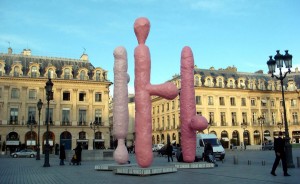 (NORTH ADAMS, Mass.) – A monumental bubble-gum pink outdoor sculptural ensemble by Franz West called Les Pommes d’Adam goes on display at MASS MoCA adjacent to the Hall Art Foundation’s 10,000 square-foot building dedicated to the work of Anselm Kiefer on Saturday, May 3, 2014. The installation marks the work’s first presentation in the United States and its second-ever showing.
(NORTH ADAMS, Mass.) – A monumental bubble-gum pink outdoor sculptural ensemble by Franz West called Les Pommes d’Adam goes on display at MASS MoCA adjacent to the Hall Art Foundation’s 10,000 square-foot building dedicated to the work of Anselm Kiefer on Saturday, May 3, 2014. The installation marks the work’s first presentation in the United States and its second-ever showing.
When Franz West’s Les Pommes d’Adam was first displayed in Paris’ Place Vendôme in 2007, the exhibition curators noted that the sculpture took its name and inspiration from the Adam’s apple, pointing to the distinctive anatomical profile of a man’s throat. The public, however, interpreted the gathering of bubble-gum pink sculptures in a slightly more provocative way, locating the reference lower on the male torso.
West would have reveled in the confusion, having once said, “It doesn’t matter what art looks like, but how it is used.” The use of art, and its interpretation by individuals, was always of interest to West. Among his earliest works are the Paßstücke, or Adaptives, a series of small, portable plaster objects, a selection of which was exhibited at MASS MoCA in 2002. Adaptives were made to be picked up and manipulated by the viewer, their meaning changing with use. Some might be utilized as bookends or flower vases, while others may be displayed on sculptural plinths.
Les Pommes d’Adam, like much of West’s work, is infused with humor and a particular delight in visual and linguistic puns. It pokes, provokes, and makes us reconsider our physical and psychological relationship to art. The sculpture’s evocation of the human body recalls the work of the Actionists, a group of artists prominent in Vienna while he was a student at the Academy of Applied Arts. Like the American Fluxus group, the Actionists sought to create art outside the usual gallery and market structure, often as free-form events or happenings that yielded abstract works of art and ritualistic, body-oriented performances.
 Les Pommes d’Adam is rough-hewn and made of basic materials: metal, epoxy, paint, and concrete. The four pink biomorphic totems, each standing at approximately 25 feet, are at once crude in shape, yet highly finished. In its Paris showing, Les Pommes d’Adam was installed in close proximity to the Vendôme Column, on top of which stands a statue of Napoléon Bonaparte in Roman garb. West’s presentation of Les Pommes d’Adam at the Place Vendôme engaged and perhaps parodied the Napoleonic Column, prompting viewers to reinvestigate it and its role in the history of Paris and France. The idiomatic expression, “Napoleon complex,” for example, takes on new meaning in light of the apocryphal tale of the etymology of the term “Adam’s apple.” According to the biblical passage, the Tree of Knowledge in the Garden of Eden was an apple tree. When Eve gave Adam a piece of the tree’s forbidden fruit and he ate it, a fragment became lodged in his throat. The Adam’s apple thus serves as a permanent reminder of the folly of desiring that which one should not have, or know. Likewise, with its monumental, if not pretentious, scale, Les Pommes d’Adam may offer a playful warning about the perils of unbridled ambition.
Les Pommes d’Adam is rough-hewn and made of basic materials: metal, epoxy, paint, and concrete. The four pink biomorphic totems, each standing at approximately 25 feet, are at once crude in shape, yet highly finished. In its Paris showing, Les Pommes d’Adam was installed in close proximity to the Vendôme Column, on top of which stands a statue of Napoléon Bonaparte in Roman garb. West’s presentation of Les Pommes d’Adam at the Place Vendôme engaged and perhaps parodied the Napoleonic Column, prompting viewers to reinvestigate it and its role in the history of Paris and France. The idiomatic expression, “Napoleon complex,” for example, takes on new meaning in light of the apocryphal tale of the etymology of the term “Adam’s apple.” According to the biblical passage, the Tree of Knowledge in the Garden of Eden was an apple tree. When Eve gave Adam a piece of the tree’s forbidden fruit and he ate it, a fragment became lodged in his throat. The Adam’s apple thus serves as a permanent reminder of the folly of desiring that which one should not have, or know. Likewise, with its monumental, if not pretentious, scale, Les Pommes d’Adam may offer a playful warning about the perils of unbridled ambition.
Franz West (1947-2012) was born in Vienna, Austria, where he studied at the Academy of Applied Arts (1977-1982) under Bruno Gironcoli. His work has been exhibited internationally, including at the Venice Biennale; documenta; Lincoln Center, New York; Centre Pompidou, Paris; the Hirshhorn Museum, Washington D.C.; and the Los Angeles County Museum of Art, and can be found in public and private collections worldwide. West collaborated with many other artists throughout his career, including Michelangelo Pistoletto and Mike Kelly. West died in 2012 at age 65.
A related exhibition of work by Franz West from the Hall Collection will be displayed at the nearby Williams College Museum of Art from June 7, 2014 to January 25, 2015.
MASS MoCA is one of the world’s liveliest centers for making and enjoying today’s most important art, music, dance, theater, film, and video. Hundreds of works of visual and performing art have been created on its 19th-century factory campus during fabrication and rehearsal residencies, making MASS MoCA among the most productive sites in the country for the creation and presentation of new art. More platform than box, MASS MoCA strives to bring to its audiences art experiences that are fresh, engaging, and transformative.
From June 21 through September 1, 2014, MASS MoCA’s galleries are open 10am to 6pm every day, Sundays through Wednesdays, with extended evening hours to 7pm on Thursdays through Saturdays, when performing arts events are often featured. In non-summer months, MASS MoCA’s galleries are open 11am to 5pm every day except Tuesdays. The Hall Art Foundation’s Anselm Kiefer exhibition is open seasonally, from spring through fall. As of June 21, 2014, gallery admission is $18 for adults, $16 for veterans and seniors, $12 for students, $6 for children 6 to 16, and free for children 5 and under. Members are admitted free year-round. For additional information, call 413.662.2111 x1 or visit MASS MoCA.
